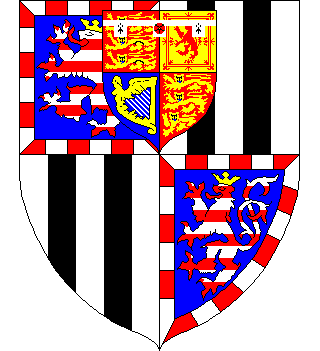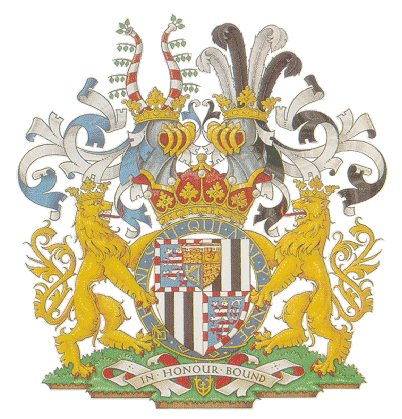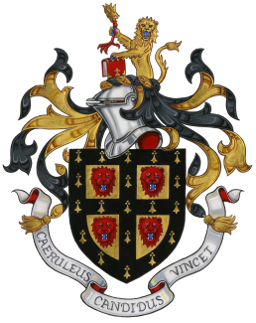Earl Mountbatten of Burma
Biography
This short biography of Earl Mountbatten of Burma concentrates on the heraldic, genealogical and related aspects of his life.
Earl Mountbatten of Burma was born H.S.H. Prince Louis Francis of Battenberg on June 25th, 1900, the younger son of Prince Louis of Battenberg and his wife Princess Victoria of Hesse. His mother was a daughter of Queen Victoria’s second daughter Princess Alice who had married the Grand Duke Louis IV of Hesse. The Battenberg family was descended from Grand Duke Louis II of Hesse through a morganatic marriage. This is reflected in Lord Mountbatten’s arms.
Prince Louis Francis entered the Royal Navy in 1913 and saw active service in the Great War.
In 1917, during the Great War, King George V changed the name of the Royal House to Windsor. At the same time, he asked those of his relatives who were British but known by German names and titles to relinquish use of them. As the head of the House of Battenberg, Lord Mounbatten’s father adopted the surname of Mountbatten and was raised to the peerage as Marquess of Milford Haven, Earl of Medina and Viscount Alderney. Since he was now the younger son of a marquess, the Prince Louis Francis of Battenberg was accordingly known as Lord Louis Mountbatten.
In the inter-war period, Lord Louis pursued his naval career with a variety of postings and specialising in communications. He also accompanied the Prince of Wales (second cousin) on two tours – to Australasia in 1920 and to the East in 1921–1922. In 1922, Lord Louis married the Hon. Edwina Cynthia Annette Ashley at St. Margaret’s, Westminster. The Prince of Wales was his best man.
Prior to the Coronation of King George VI in 1937, Lord Louis was appointed a G.C.V.O. and indeed wore the mantle at the Coronation service. In the same year, he was promoted to Captain. When war broke out in 1939, he commanded the 5th Destroyer Flotilla from H.M.S. Kelly and saw service in the North Sea, the Western Approaches and the Mediterranean being appointed D.S.O. in 1941. The sinking of the Kelly in the same year during the Battle of Crete was to feature in the film In Which We Serve in which Lord Louis was played by Noel Coward. For a short period afterwards, he was in command of H.M.S. Illustrious, an aircraft carrier.
Lord Louis was appointed Commodore in 1941 and later held the post of Chief of Combined Operations when he investigated strategies for the eventual liberation of Europe. In 1943, however, his career took a major change of direction when he was appointed Supreme Allied Commander, South East Asia Command with the rank of acting Admiral. This culminated with Japanese forces being driven out of Burma and the surrender of Japanese forces in Malaya in 1945.
After the end of the World War, Lord Louis was appointed a K.G. and ennobled as Viscount Mountbatten of Burma in 1946. In the following year he was appointed a Privy Councillor and was advanced in the peerage to Earl Mountbatten of Burma and Baron Romsey. He was also appointed to a number of foreign orders at this time.
It was in 1947 that Lord Mountbatten was appointed Viceroy of India and, as such, became the Grand Master of the two Indian orders – the Star of India and the Indian Empire. This included automatic appointment to the the highest ranks of these two orders, G.C.S.I. and G.C.I.E. respectively. He had become a K.St.J. in 1943. After the partition of India, Lord Mountbatten remained as Governor-General until 1948.
As a serving officer in the armed forces, Lord Mounbatten progressed through the Order of the Bath. He was appointed to the order in 1943 as a C.B. He was advanced to K.C.B. in 1945 and finally to G.C.B. in 1955 when he became the First Sea Lord. In the following year, he was promoted from Admiral to Admiral of the Fleet, the highest rank in the Royal Navy. Following his retirement as Chief of Defence Staff in 1965, he was appointed O.M.
Lord Mountbatten was also Governor (later Lord Lieutenant) of the Isle of Wight, Colonel of the Life Guards and Colonel Commandant of the Royal Marines.
Lord Mountbatten’s connection with Cambridge much predated his being President of C.U.S.G. and later being Patron of C.U.H.&G.S. He matriculated at Christ’s College in 1919 and was both admitted to the degree of LL.D. honoris causa and elected an Honorary Fellow of his college in 1946.
Bibliography
- Allison, R. and Riddell, S., The Royal Encyclopedia, London: Macmillan Press, 1990.
- Duff, D., Hessian Tapestry, London: Frederick Muller, 1967.
- Eilers, M.A., Queen Victoria’s Descendants, Falköping (Sweden): Rosvall Royal Books, second edition, 1997 [ISBN 91-630 5964-9].
- Galloway, P., Stanley, D. and Martin, S., Royal Service, Volume I, Victorian Publishing, 1996.
- Louda, J. and Maclagan, M., Lines of Succession, London: Orbis, 1981 [ISBN 0-85613-672-7].
- Mountbatten, Lord [pictures selected by], Mountbatten – Eighty Years in Pictures, London: Macmillan, 1979.
- Smith, C., Fifty Years with Mountbatten, London: Sidgwick and Jackson, 1980 [0 283 98677 8].
- Terraine, J., The Life and Times of Lord Mountbatten – An Illustrated Biography Based on the Television History, London: Hutchinson, 1968 [0090888103].
- Vickers, H., Royal Orders – The Honours and the Honoured, London: Boxtree, 1994.
- Ziegler, P., Mountbatten – The Official Biography, Collins, 1985.
- Article from The Daily Telegraph.
A newsgroup about Lord Mountbatten exists.
Arms

Shield – Quarterly: first and fourth, azure, a lion rampant double queued barry of ten argent and gules, armed and langued of the last, crowned or, within a bordure compony of the second and third; second and third, argent, two pallets sable charged on the honour point with an escutcheon of the arms of the late Princess Alice (namely, the Royal Arms differenced with a label of three points argent, the centre point charged with a rose gules barbed vert, and each of the other points with an ermine spot sable).

Crests – First, out of a coronet or, two horns barry of ten, argent and gules, issuing from each three linden leaves vert, and from the outer side of each horn four branches barwise, having three like leaves pendant therefrom of the last (Hesse); second, out of a coronet or, a plume of four ostrich feathers alternately argent and sable (Battenberg).
Supporters – On either side a lion double queued and crowned all or.
Motto – In Honour Bound
Peerage Titles
In 1946, the then Lord Louis Mountbatten was created:
- Viscount Mountbatten of Burma, of Romsey. co. Southampton
in the peerage of the United Kingdom with remainder to heirs male of his body, and in default of such issue to his elder daughter, Patricia Edwina Victoria, and the heirs male of her body; and in default of such issue to every other daughter successively in order of seniority of age and priority of birth, and to the heirs male of their bodies.
In the following year, 1947, Viscount Mountbatten of Burma was advanced in the peerage of the United Kingdom to:
- Baron Romsey, of Romsey. co. Southampton; and
- Earl Mountbatten of Burma
with similar special remainders.
At his death, he was succeeded in all his peerage titles by his elder daughter, Lady Brabourne. As the eldest son of the Countess Mountbatten of Burma, the Hon. Norton Knatchbull became known by the courtesy title of Lord Romsey.
Membership of British Orders of Chivalry
Lord Mountbatten was a member of five of the United Kingdom’s nine (national) orders of chivalry.
The Most Noble Order of the Garter (1348)
The senior order of chivalry in the United Kingdom. One rank only.
- Appointed Knight Companion (K.G.), 1945.
The Most Honourable Order of the Bath (1725)
Membership of this order is normally awarded to high-ranking military and civil servants of the Crown. It is split into two divisions, military and civil, each having three ranks.
- Appointed Companion (C.B.), 1943;
- Advanced to Knight Commander (K.C.B.) in 1945;
- Advanced to Knight Grand Cross (G.C.B.) in 1955.
The Most Exalted Order of the Star of India (1861)
In 1947, Lord Mountbatten was appointed Viceroy of India. The Viceroy was Grand Master of this order _ex officio and, simultaneously, appointed to the rank of Knight Grand Commander within it. The two lower ranks are Commander (C.S.I.) and Knight Commander (K.C.S.I.)._
- Appointed Knight Grand Commander (G.C.S.I.), 1947.
The Most Eminent Order of the Indian Empire (1868)
In 1947, Lord Mountbatten was appointed Viceroy of India. The Viceroy was Grand Master of this order _ex officio and, simultaneously, appointed to the rank of Knight Grand Commander within it. The two lower ranks are Commander (C.I.E.) and Knight Commander (K.C.I.E.)._
- Appointed Knight Grand Commander (G.C.I.E.), 1947.
The Royal Victorian Order (1896)
An order created by Queen Victoria to reward those rendering personal service to the Sovereign and the Royal Family. It has five ranks: Member (fomerly Member (fifth class)), Lieutenant (formerly Member (fourth class)), Commander, Knight Commander and Knight Grand Cross.
- Appointed Member (fifth class) (M.V.O.), 1920 – on the staff of H.R.H. the Prince of Wales during Australian and New Zealand tour, 1920;
- Advanced to Knight Commander (K.C.V.O.), 1922 – on the occasion of his marriage and following his return as Naval A.D.C. to H.R.H. the Prince of Wales during Indian tour;
- Advanced to Knight Grand Cross (G.C.V.O.), 1937 – on the occasion of the coronation of King George VI [Lord Louis was appointed Personal Naval A.D.C. to the King in the same year].
Strictly speaking (and though very different to each other), neither of the following is an order of chivalry; however, membership of each is highly prized.
Created by King Edward VII and restricted to 24 members but confers no precedence. Divided into military and civil divisions but with one rank only.
- Member (O.M.), 1965.
The Distinguished Service Order (1886)
Instituted by Queen Victoria and awarded to members of the armed forces (also Mercantile Marine), this has aspects of both an order of chivalry (but with only one rank) and a military decoration (bars can be awarded).
- Companion (D.S.O.), 1941.
The Most Venerable Order of the Hospital of Saint John of Jerusalem
Although not a national order of chivalry, the Order of St. John enjoys a well-established semi-official status and, indeed, H.M. the Queen is its Sovereign Head.
- Knight (K.St.J.), 1943.
For completeness, the four other British orders of chivalry are:–
- The Most Ancient and Most Noble Order of the Thistle (revived 1687) – generally restricted to Scottish peers (one rank of Knight (K.T.));
- The Most Illustrious Order of St. Patrick (1783) – the Irish equivalent of the Garter and the Thistle … no appointments since 1936, however (one rank of Knight (K.P.));
- The Most Distinguished Order of St. Michael and St. George (1818) – primarily for members of the diplomatic and consular services (three ranks exactly as the Order of the Bath and with post-nominal letters C.M.G., K.C.M.G. and G.C.M.G.);
- The Most Excellent Order of the British Empire (1917) – by the far the largest order and the one to which those whose eminence is not specifically associated with one of the other orders are appointed. There are five ranks: Member (M.B.E.), Officer (O.B.E.), Commander (C.B.E.), Knight or Dame Commander (K.B.E. or D.B.E.), Knight or Dame Grand Cross (G.B.E.).
- There is also an order called the Companions of Honour (1917) – sometimes regarded as a junior class of the Order of Merit. It consists of 65 ordinary members (C.H.).
Membership of Foreign Orders of Chivalry
Lord Mountbatten was a member of a number of foreign orders.
- Grand Cross of the Order of Louis of Hesse;
- The Order of the Rising Sun, fourth class, 1922 – Japan;
- The Order of the Nile, fourth class, 1922 – Egypt;
- Grand Cross of the Order of Isabella Catolica, 1922 – Spain;
- Grand Cross of the Order of the Crown, 1924 – Roumania;
- Grand Cross of the Order of the Star, 1937 – Roumania;
- Greek Military Cross, 1941 – Crete;
- Legion of Merit, 1943 – United States of America;
- Distinguished Service Medal, 1945 – United States of America;
- Special Grand Cordon of the Cloud and Banner, 1945 – China;
- The Order of the White Elephant, 1946 – Siam;
- Grand Cross of the Most Refulgent Order of the Star, 1946 – Nepal;
- Grand Cross of the Legion of Honour, 1946 – France;
- Grand Cross of the Order of George I, 1946 – Greece;
- Grand Cross of the Order of the Lion, 1947 – Netherlands;
- Grand Cross of the Military Order of Aivz, 1951 – Portugal;
- The Order of Seraphim, 1952 – Sweden;
- Agga Maha Thiri Thuddhamma, 1956 – Burma;
- Grand Cross of the Order of Dannebrog, 1962 – Denmark;
- Grand Cross of the Order of the Seal of Solomon, 1965 – Ethiopia;
- The Most Esteemed Family Order, 1972 – Brunei.
Naval Career
- 1913 – Entered Royal Navy
- 1916 – Rated Midshipman
- Served on:
- _H.M.S._ Lion, 1916;
- _H.M.S._ Queen Elizabeth, 1917;
- _H.M. Submarine_ K6, 1918.
- Served on:
- 1918 – Promoted Sub-Lieutenant
- Served on H.M.S. P31.
- 1920 – Promoted Lieutenant
- Served on:
- H.M.S. Renown, 1920 (Prince of Wales' Tour, Australia and New Zealand);
- H.M.S. Repulse, 1921
- H.M.S. Renown, 1920 (Prince of Wales' Tour to India, Japan and the Far East);
- H.M.S. Revenge, 1923;
- Signal School, Portsmouth, 1924;
- R.N. College, Greenwich, 1925;
- Reserve Fleet Wireless and Signal Officer, 1926;
- Assistant Fleet Wireless Officer, Mediterranean Fleet, 1927–1928.
- Served on:
- 1928 – Promoted Lieutenant-Commander
- Second Destroyer Flotilla Signal and Wireless, 1928–1929;
- Senior Instructor in Wireless at H.M. Signal School, Portsmouth, 1929–1931;
- Fleet Wireless Officer, Mediterranean Fleet, 1931–1933.
- 1932 – Promoted Commander
- Qualified as interpreter in French and German, 1933;
- In command of H.M.S. Daring, 1934;
- In command of H.M.S. Wishart, 1935;
- Appointed to Naval Air Division at Admiralty, 1936.
- 1937 – Promoted Captain
- In command of H.M.S. Kelly and Fifth Destroyer Flotilla, 1939 (mentioned in dispatches twice);
- In command of H.M.S. Illustrious, 1941.
- 1941 – Promoted Commodore (First Class)
- Commodore, Combined Operations, 1941–1942;
- Chief of Combined Operations and Member of Chief of Staff’s Committee with rank of acting Vice-Admiral, 1942–1943;
- Supreme Allied Commander, South-East Asia with rank of acting Admiral, 1943–1946.
- 1946 – Promoted Rear-Admiral
- Flag Officer commanding First Cruiser Squadron, Mediterranean Fleet, 1948–1949.
- 1949 – Promoted Vice-Admiral
- Fourth Sea Lord, 1950–1952;
- Commander-in-Chief, Mediterrnean, 1952–1954.
- 1953 – Promoted Admiral
- Commander-in-Chief, Allied Forces, Mediterrnean, 1953–1954;
- First Sea Lord, 1955–1959.
- 1956 – Promoted Admiral of the Fleet
- Chief of the Defence Staff and Chairman of the Chiefs of Staff Committee, 1959–1965.
- 1965 – Retired
Scholastic Distinctions
- Matriculated Christ’s College, Cambridge, 1919;
- Became Chartered Electrical Engineer, 1927;
- Elected Honorary Fellow, Christ’s College, Cambridge, 1946;
- Elected a Fellow of the Royal Society, 1966;
- Honorary Degrees:–
- Doctor of Laws (LL.D.), University of Cambridge, 1946;
- Doctor of Civil Law (D.C.L.), University of Oxford, 1946;
- Doctor of Science (D.Sc.), University of Delhi, 1948;
- Doctor of Science (D.Sc.), University of Patna, 1948;
- Doctor of Laws (LL.D.), University of Leeds, 1950;
- Doctor of Laws (LL.D.), University of Edinburgh, 1954;
- Doctor of Laws (LL.D.), University of Southampton, 1955;
- Doctor of Laws (LL.D.), University of London, 1960;
- Doctor of Laws (LL.D.), University of Sussex, 1963.
